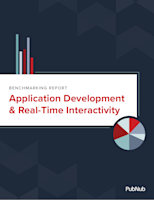
Instagram's social media app has profoundly transformed since its inception in 2010. It started as the photo alternative to Facebook's endless status updates, adopted a "Stories" feature to compete with Snapchat's disappearing videos, and then rolled out "Reels" to compete with TikTok.
But more users are interacting with the app solely through their DMs—direct messages—and the app will soon use generative artificial intelligence (AI) (with the help of large language models (LLMs) to create a dynamic experience even in these private chats.
Instagram's development team is working on a chatbot that would allow users to ask AI questions, not in a separate chat thread, but right from wherever they are. It could answer questions and even take on different personas. And while this capability isn't ready yet, it indicates how ubiquitous AI will be for app users. This is what makes a genuinely dynamic app chat experience.
The essence of dynamic app conversations
Dynamic app conversations aren't just about getting the chatbot to respond to user inputs on digital platforms. That's the starting point. Truly effective conversational AI with a human touch involves:
The comprehension of context
Modifying responses in real time
Personalizing interactions based on that user's specific history
Even predicting potential user needs
The benchmark for remarkable performance by AI when it comes to app conversations includes several key elements:
Use of NLP: Natural language processing is the cornerstone of these apps. It allows AI to understand what humans are asking—without using the ultra-formal, stilted language laced with "keywords"—including non-text sources, such as audio or video files, that today’s AI models are known for.
Contextual language understanding: Remember the early days of AI conversations when you could trick the bot into hilarious responses based on basic misunderstandings that a human would never make? It's not so funny anymore. Today, users expect the bot to recognize the current situation the user is in, as well as the environment.
Real-time adaptation: Modifying the conversation flow instantly in response to evolving context ensures the bot provides human-like interactions that users crave. Otherwise, the bot becomes another obstacle to developing deeper customer relationships.
Personalization: Past user interactions can help inform bot interactions. This ensures the conversations are appropriate for the context, valuable to the user, and seamless execution. An excellent case study on this is Amazon’s real-time updating of product recommendations based on past and present shopping behavior.
Multimodal interactions: One of the biggest developments in using AI-supported app conversation tools is the ability to merge text, voice, and visuals for richer conversations. Users find greater value and clarity, and the bot has interaction flexibility.
Predictive responses: Another incredible development is the bot's ability to predict what a user says or needs based on historical data. This could enable bots to formulate questions based on user actions happening in real time and adapt quickly to keep customers engaged.
Continuous learning and improvement: Advanced machine learning algorithms process big data and perform the optimization on themselves to improve customer responses continually.
Quite a few industries are great use cases for new dynamic app conversations:
Product recommendations based on browsing history in popup chats
Real-time chat support for customer queries
Shopping assistants that understand user behavior, preferences, and suggest items via the app
Virtual health assistants offering personalized advice through integrated apps
Chat-based appointment booking based on patient history and needs
Medication reminders and symptom tracking via conversation streams
Banking and financial services:
Personalized financial advice bots
Transaction tracking and fraud alert conversations and push notifications
Quick query resolution through chatbots
Hospitality and travel:
Hotel booking assistants suggesting rooms based on past preferences
Travel planning bots offering itinerary suggestions
Real-time language translation
Education and e-learning:
Adaptive learning platforms that guide based on student performance
Virtual AI-driven tutors offering personalized assistance
Bots answering common student queries
Automotive and smart vehicles:
In-car voice assistant apps for navigation, music, or making calls
Diagnostic tools that explain vehicle issues in a conversational manner
Chat-based content or voice-controlled recommendation systems based on viewing habits
AI agents guiding users through media libraries
Real estate:
Virtual property tour assistants
Bots that gather user preferences to suggest properties
Bots that help home buyers and sellers walk through the process step by step
Food delivery and restaurants:
Chatbots suggesting dishes based on past orders
Real-time order tracking and support
In-game assistants providing hints or guiding players
Conversational interfaces for game settings and support
Chat moderation and filtering for safer, more welcoming experiences
Customer service and support:
Bots resolving common customer issues without human intervention
Virtual assistants guiding users through troubleshooting processes
Utilities and smart homes:
Voice-controlled home automation systems via a single app dashboard
Conversational interfaces for managing utility bills, services, and answering pricing questions.
Any industry interacting directly with its users can benefit from a more personalized, context-aware, and efficient communication system by utilizing dynamic app conversations.
Talk to an Expert
Let's connect to discuss your real-time project.
Generative AI: The heart of dynamic app conversations
AI transforms static app interactions into fluid dialogs, specifically natural language processing and machine learning.
Crafting tailored experiences
Customers expect companies to know them, understand their preferences, and remember their past activities. This isn't just a pleasant surprise for customers but a bare minimum requirement for interactions moving forward.
AI can curate conversations by analyzing user data, helping them resonate personally, and delivering real value and an excellent user experience. For example, a news app might provide content recommendations similar to the Netflix recommendation engine as users engage with the app.
Bridging language barriers in real time
AI-driven language translation can make apps more accessible to a broader audience by making app content available in their preferred language. For example, a travel app could suggest local experiences based on your geographic location and previous activity in your chosen language.
And speaking of language, AI-powered chat features allow users to filter out unwanted language, such as curse words, in real time. This makes activities like live events in the app a safer, more welcoming place.
Anticipating user needs
Many industry examples above anticipate user needs to encourage greater engagement and provide support. For example, a banking app might predict a user's intent to explore loan options after they check mortgage rates and offer tailored recommendations for improving the chances of receiving a mortgage.
In all these cases, humans are available for more important tasks, but AI allows users to serve themselves first, seamlessly and without friction.
Charting the horizon: What lies ahead for AI-powered app conversations
AI will only continue to advance customer experience capabilities within apps. Organizations may soon employ more sophisticated analytics to help predict customer responses across channels, anticipate needs, and assist in more complex decision-making. This turns chatbots from primarily reactive to proactive tools designed to remove friction from the customer experience. We may even see AI-driven voice technology bring new layers of interactivity.
Additionally, adding augmented reality capabilities could provide users with even more immersive experiences, especially valuable in retail or travel sectors.
Unraveling the future of dynamic conversation
Dynamic app conversations are the cornerstone of next-generation customer engagement. Users expect personalization and ease with each interaction, and companies can deliver those experiences reliably with a strategic AI-driven foundation. The line between human and app conversations will continue to blur as we advance, leading to an era where apps understand, predict, and converse seamlessly. A future where AI interactions are indistinguishable from human interactions is on the horizon.
With platforms like PubNub, developers have many tools to weave AI technology into their mobile app fabric, making each interaction more human-like and intuitive. PubNub's platform—which now includes OpenAI GPT API integration—allows companies to create cutting-edge, dynamic apps capable of incredible functionality and scale without months of development or costly iterations.
Sign up for a free trial to see how you can build your app with dynamic conversations.


